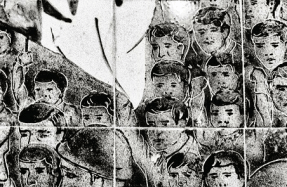
Duane Michals doesn’t mince words—about his photography, or anyone else’s. And why should he? Born in 1932 in McKeesport, Pennsylvania, Michals had traveled the world by age thirty, from the truck stops of Texas to army service in Germany to the gray-gold landscape of Cold War Russia. By the mid-1960s, he found a home in downtown New York, a partner in the late architect Fred Gorrée, and the kind of success in commercial and editorial photography that allowed him to take risks in his own work: building sequences with the theatrical engagement of cinema, staging narratives about queer desires, and adding text in his unmistakable script. Michals risked sentimentality in pursuit of talking about “unphotographable things.”
Last September, in the balm of late summer, Michals welcomed Jesse Dorris into the Gramercy Park apartment Michals shared for decades with Gorrée. Among framed photographs and stacks of books—Michals has published more than forty—they spoke about desire and fate. “I am moved by my work,” Michals says. “The deep contentment of having written a really good sentence or having taken a really good picture, knowing that I’ve done it, is very sweet. It makes me melancholy… in a nice way.”
Jesse Dorris: What’s the difference between luck and fate?
Duane Michals: Fate is fate. You’re predestined. This conversation was destined to happen. We’re just fulfilling the destiny. I don’t believe in that. I believe in accidents. I believe in spontaneous combustion. I believe that every second we’re inventing a new universe. I believe in… [Sings] “I believe in magic…” I also have a song for every occasion.
JD: I’m curious as to how you make the decision between staging a moment and willing something to happen, or setting up an occasion and just letting something magical happen, or going out and stumbling upon something.
DM: Instinct. I trust my instinct more than I trust me. I’m completely unreliable. I wouldn’t trust me if my life depended on it. I’m going to my hometown in McKeesport, making a movie this weekend. McKeesport has fallen on hard times. It’s collapsed. Imploded. I used to go to the library all the time. I once took out a book nine times, and they wouldn’t let me have it anymore. I never got over it.
JD: What was the book?
: It was called . There were photographs of every major city. I wasn’t interested in photography. I was interested in the cities. Fred and I had a house in the country for forty-four years, near Bennington, in the woods. I used to build model cities in the woods.






